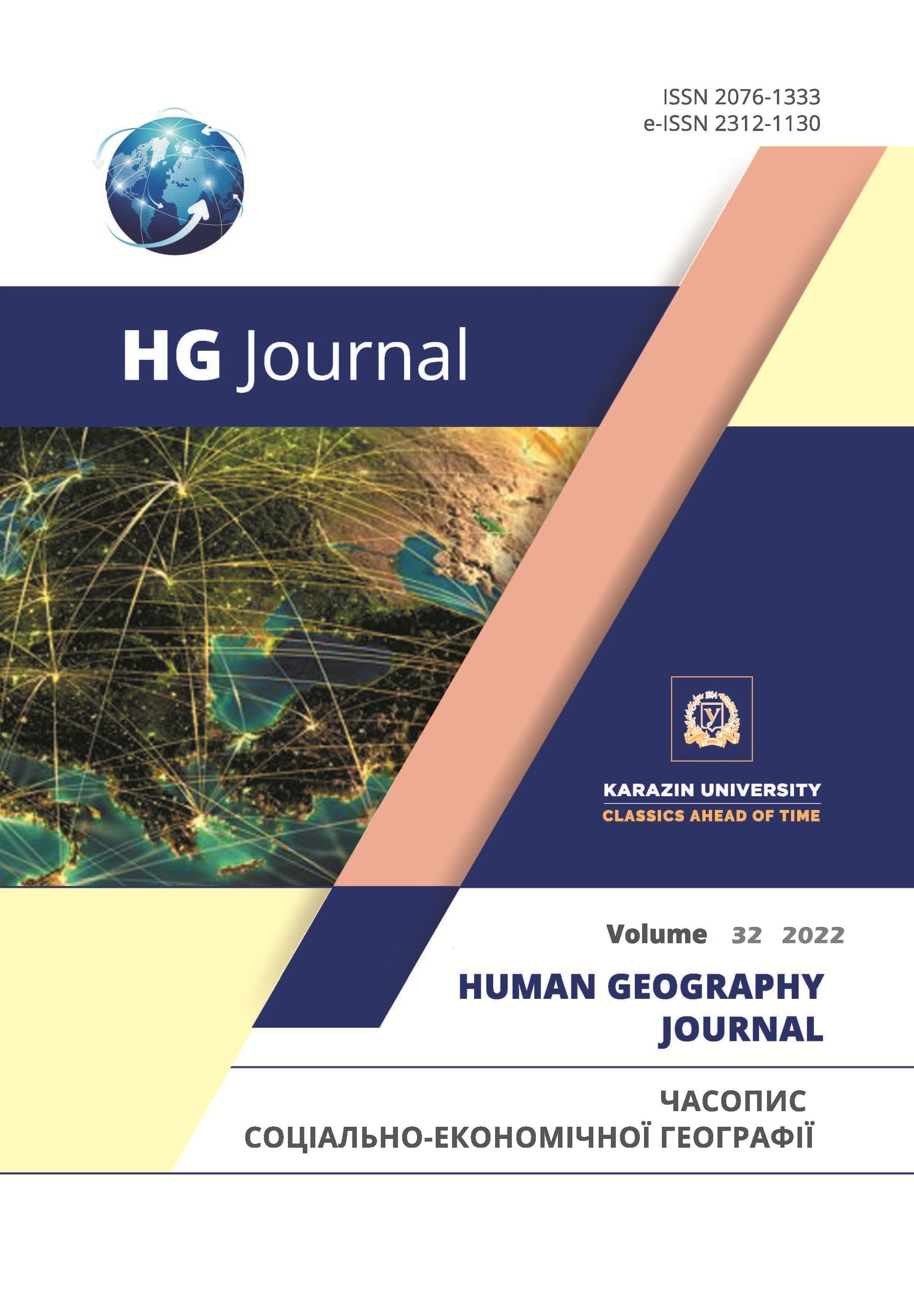Теоретичні засади просторового аналізу історії адміністративно-територіального поділу
Анотація
У статті розглянуто теоретичні аспекти просторового та просторово-часового аналізу змін адміністративно-територіального поділу, його історії. Показано, що незважаючи на наявність значної кількості публікацій з історії адміністративно-територіального поділу, комплексно питання його детального просторового аналізу так і не вирішено. Головна увага автора статті зосереджена на діахронічному аналізі. Виділено рівні аналізу в залежності від того, який об’єкт з історії територіального поділу аналізується (одновимірні лінійні об’єкти – адміністративні межі, динамічні полігональні об’єкти – адміністративні одиниці, об’єкти, що позначають зміни, або довільні території та території з єдиною історією адміністративної належності, у межах яких узагальнюється історія конкретних об’єктів з історії адміністративно-територіального поділу із розрахунком відповідного агрегативного показника).
Охарактеризовано відмінність між вивченням змін як частини історії конкретних об’єктів територіального устрою і вивченням змін як окремих просторових об’єктів. Описано принципи виділення ареалів просторових змін, їх різновиди. Для кожного рівня аналізу запропоновано та детально описано типи об’єктів, які можуть бути одиницями картографування на аналітичних чи синтетичних картах з історії адміністративно-територіального поділу. Розглянуто типові операції над просторово-часовими даними з історії територіального поділу. Наведено приклади конкретних показників з історії адміністративно-територіального поділу, які можуть бути розраховані для описаних об’єктів. Охарактеризовано відмінності у розрахунку схожих за смислом показників для об’єктів різних типів. Особливу увагу приділено показникам-агрегатам з історії адміністративно-територіального поділу у межах окремих територій. Наведено класифікації таких показників. Зокрема виділено локальні агрегати, фокальні та агрегати динамічних об’єктів. Наведено приклади аналізу адміністративної реформи 2020 р. на районному рівні у межах Дніпропетровщини. Коротко охарактеризовано особливості компаративного аналізу окремих станів чи періодів для різних об’єктів змін.
Завантаження
Посилання
Vasilyev, A. P. (2019). Transformaciya sistem administrativno-territorial`nogo deleniya stran zarubezhnoj Evropy` (na primere Francii, Germanii i Khorvatii) [Transformation of systems of administrative territorial division of foreign Europe countries (on the example of France, Germany and Croatia]. Candidate’s thesis. Moscow. Retrieved from http://igras.ru/sites/default/files/announcements/Васильев-диссертация.pdf [in Russian].
Vermenych, Ya. V., & Androshchuk, O. V. (2014). Zminy administratyvno-terytorialnoho ustroiu Ukrainy ХХ–ХХІ st. [Changes in the administrative-territorial structure of Ukraine XX-XXI centuries]. Institute of History of Ukraine, 182 [in Ukrainian].
Efimov, S. A., Shevchuk, A. G., & Selezneva, O. A. (2007). Administrativno-territorialnoe delenie Kryma vtoroj poloviny XX veka: opyt rekonstrukcii [Administrative-territorial division of Crimea in the secondhalf of 20th century: reconstruction experience]. Uchenye zapiski Tavricheskogo Natsionalnogo Universiteta im. V.I. Vernadskogo – Scientific notes of the Vernadsky Tauride National University. Series «Geography, 20(59)(1), 39-50 [in Russian].
Igonin, A. I., & Tikunov, V. S. (2018). Rossijsko-ukrainskaya granicza – proisxozhdenie i ustojchivost` [Russian-Ukrainian border – origin and stability]. Naselenie i ekonomika – Population and economy, 2(4), 136-160 [in Russian].
Igonin, A. I. (2016). Geoinformacionny`j analiz ustojchivosti administrativny`x granicz rossijsko-ukrainskogo porubezh`ya [Geoin-formation analysis of the stability of the administrative borders of the Russian-Ukrainian border]. Geodeziya i kartografiya – Geodesy and Cartography, (9), 54-59 [in Russian].
Malienkova, Kh. O. (2020). Metody vyvchennia prostorovykh aspektiv reformuvannia administratyvno-terytorialnoho podilu [Methods of studying the spatial aspects of reforming the administrative-territorial division] Naukovi zapysky Khersonskoho viddilu Ukrainskoho heohrafichnoho tovarystva: zb. nauk. prats / za red. I. O. Pylypenka, D. S. Malchykovoi – Scientific notes of the Kherson department of the Ukrainian Geographical Society: coll. Science. works / ed. I. O. Pilipenko, D. S. Malchikova, 12, 50-55 [in Ukrainian].
Manakov, A. G., & Evdokimov, S. I. (2010). Ustojchivost` granicz Pskovskogo regiona: istoriko-geograficheskij analiz [Stability of the borders of the Pskov region: historical and geographical analysis]. Pskovskij regionologicheskij zhurnal – Pskov Journal of Regional Studies, (10), 29-48 [in Russian].
Markova, L. M. (2011). Istoriia heohrafii: administratyvno-terytorialnyi ustrii Dnipropetrovshchyny na pochatku KhKh stolittia [History of geography: administrative-territorial structure of Dnipropetrovsk region in the early twentieth century]. Dn-k.: DOUNB [in Ukrainian].
Tarkhov, S. A. (2001). Izmenenie administrativno-territorialnogo deleniia Rossii za poslednie 300 let [Changes in the administrative-territorial division of Russia over the past 300 years]. Geografiia – Geography, 15, 1-32 [in Russian].
Tarkhov, S. A. (2019). Osnovnye prostranstvennye zakonomernosti evoliutsii setki administrativno-territorialnogo deleniia Rossii za 300 let [Basic spatial regulations of the evolution of the network of the administrative territorialmanagement of Russia for 300 years]. Pskovskii regionologicheskii zhurnal – Pskov Journal of Regional Studies, 4 (40), 16-33 [in Russian].
Trotsenko, O. V. (2008). Doslidzhennia zmin administratyvno-terytorialnoho ustroiu rehionu yak bazovoi skladovoi systemy vtra-chenykh heohrafichnykh obiektiv (na prykladi Dnipropetrovskoi oblasti) [Investigation of changes in the administrative-territorial structure of the region as the basic component of the system of lost geographic objects (for example, Dnipropetrovsk region)]. Naukovi zapysky Vinnytskoho pedahohichnoho universytetu – Scientific notes of Vinnytsya State Pedagogical University named after Michailo Kotzubynsky. Series: Geography, 17, 25-30 [in Ukrainian].
Berman, Merrick Lex. (2009). Modeling and Visualizing Historical GIS Data. Retrieved from http://www.fas.harvard.edu/~chgis/work/docs/ papers/CGA_Wkshp2009_Lex_9apr09.pdf
Gregory, I. N. (2003). A place in history: A guide to using GIS in historical research. Arts, & Humanities Data Service (England). History Data Service. (p. 335). Oxford: Oxbow.
Nüssli, M., & Nüssli, C. (n.d.). From Historical Mapping to Historical Geographical Information System. Euratlas. History and Ge-ography of Europe and the World. Retrieved from https://www.euratlas.net/tele/euratlas_HGIS.pdf
Авторське право (c) 2022 Олександр Гаврюшин

Цю роботу ліцензовано за Міжнародня ліцензія Creative Commons Attribution 4.0.




